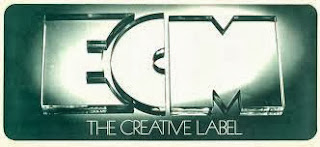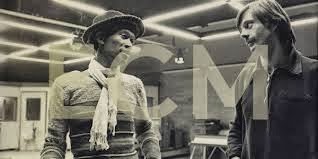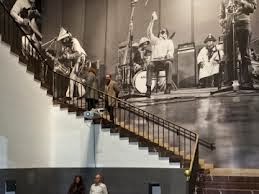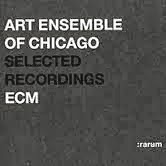The music we are given here is
typical of a trend that may destroy diversity, that may become a norm managing
music at some global level. Jazz is a style, or even a genre that implies any
musical object can be dealt with along this style. John Steinbeck reported a
long time ago his answer to a question someone asked him in the USSR
about jazz. He answered that you can take Any musical piece of any tradition
and you just produces it in a jazzy way and you have jazz. This is genetically
modified music and you import into any music that genetic element called jazz.
But then the original music is no longer what it was originally. In our days of
genuine fidelity to what the music was or is in its real context, this
rewriting of everything in a jazz style is homogenizing.
What’s more, as we are going to see, it is one criticism the musicians of this
ECM label leveled at what jazz had become in the consumer’s society: a
commodity, nearly elevator music. The danger in jazz is that it becomes, is
becoming, always and systematically a standard often questioned and even
rejected by some but to be replaced by another standard. It is obvious with
these CDs that improvisation is non-existent since the music is recorded. They
may be the recordings of improvised pieces but as soon as they are recorded
they are no longer improvised. That’s where the DVD would be a better medium
because then we would see the improvisation, not live but dead alive if I dare
say so. On a CD it is necessarily dead by dissection.

Location: Olliergues, France
More Info: ECM A CULTURAL
ARCHAEOLOGY – OKWUI ENWEZOR & MARKUS MÜLLER, eds. – PRESTEL VERLAG, MUNICH
– LONDON – NEW YORK – 2012, catalogue of the ECM, A Cultural Archaeology
exhibition, Haus der Kunst, Munchen, November 23, 2012 – February 10, 2013,
Publisher: Editions
La Dondaine
Publication Date: Sep 28, 2013
Research Interests:
Music As the
Core of Human Intelligence,
Human
Intelligence and Art,
Brain - Mind
Speed of Development,
Brain Versus
Mind,
Hardware -
Software Speed of Development,
Second
Industrial Revolution,
Postmodernism,
Free at Last,
I Have a
Dream Speech,
Martin Luther
King Jr.,
Improvisation,
Jazz and
Black Music,
Free Jazz,
Jazz, and
Music
SELECTED SIGNS – III-VIII – AN ANTHOLOGY FOR THE EXHIBITION ECM – A
CULTURAL ARCHAEOLOGY – HAUS DER KUNST – MUNICH
– ECM Records GmbH – MUNCHEN – 2013
The music we are given here is
typical of a trend that may destroy diversity, that may become a norm managing
music at some global level. Jazz is a style, or even a genre that implies any
musical object can be dealt with along this style. John Steinbeck reported a
long time ago his answer to a question someone asked him in the USSR about
jazz. He answered that you can take Any musical piece of any tradition and you
just produces it in a jazzy way and you have jazz. This is genetically modified
music and you import into any music that genetic element called jazz. But then
the original music is no longer what it was originally. In our days of genuine
fidelity to what the music was or is in its real context, this rewriting of
everything in a jazz style is homogenizing.
What’s more, as we are going to
see, it is one criticism the musicians of this ECM label leveled at what jazz
had become in the consumer’s society: a commodity, nearly elevator music. The
danger in jazz is that it becomes, is becoming, always and systematically a
standard often questioned and even rejected by some but to be replaced by
another standard. It is obvious with these CDs that improvisation is
non-existent since the music is recorded. They may be the recordings of
improvised pieces but as soon as they are recorded they are no longer
improvised. That’s where the DVD would be a better medium because then we would
see the improvisation, not live but dead alive if I dare say so. On a CD it is
necessarily dead by dissection.

I say it is a danger in that
procedure, but in these CDs many pieces are really original in tone or in
treatment of the musical objects. But yet the trio or the quartet is a form
that comes back over and over again. Such small “bands” were invented (in fact
borrowed even if not consciously) by jazz because of the small places where
they could perform, like churches, and because that Jazz was born in the
poorest strata of the poorest class of the American society: the Blacks just
after slavery and in the midst of segregation. It was practically clandestine
at the time, if not outlawed by authorities and rejected by the white majority
as degenerate, like the Black monkeys who were playing it. After a while, when
listening to the CDs I seem to regret the absence of variations in these three
or four musicians and the rather regular processing we have: the cult of the
solo part in the middle of a piece. Rare are the real duets in these records,
and when a real duet appears, it is a marvelous moment. Such moments could and
should be multiplied.
The tendency of a chaotic
architecture in many pieces is not a real challenge to the rather dominant
formal elements. Chaos is interesting in many ways but it has to get to some
kind of pattern to be meaningful, and that is not always true. Then we have the
trumpet for the sake of the trumpet, or the double bass for the sake of the
double bass. As Picasso would say, when you only use one color to paint with no
real shape or form, then you just paint blue. Many pieces are just that. They
play trumpet, or saxophone, or double bass, or drums, with rhythmic patterns
that are basically always similar. To have several rhythmic patterns
superimposed one onto the other can only lead for us to some beauty if the
patterns build together a higher meta-pattern. We are too often missing that
meta-level when we do not have the traditional patterns.

I am all for the use of Bach’s or
Mozart’s or Shostakovich’s music in jazz. But it has to be clearly said it is
variations on Bach’s music and not Bach’s music. Many musicians have done that
over the centuries, used the music of someone else, but they never pretended it
was that music of someone else. Actually we cannot even know if it is the real
score of the original music performed in a new jazzy way or if it is a set of
variations on the original score.
I have heard some Vivaldi violin
piece played in the typical gypsy or fiddler on the roof style. It was
impressive but it was not Vivaldi any more because Vivaldi never thought of his
music being played that way. Ivry Gitlis performed that particular
“improvisation” in La Chaise-Dieu as an encore at the end of a Vivaldi concert
in which he had been the violin soloist. Ivry Gitlis can afford that
originality in an encore but that would be very questionable if a whole Vivaldi
concert were performed that way. Anyway it would not be Vivaldi any more but
(and I DO NOT say only) variations on some scores by Vivaldi.

In other words and to conclude
this general remark, I find it hard at times, and even quite a few times, to
capture e meaning in the music we are given and when the words or the music of
someone else are used, there is always an iconoclastic approach that bothers
me: Blake is not used to the full meaning of his poetry. Henry Vaughan is
reduced to little. The words of Heiner Müller or Bertolt Brecht are interesting
but they are given as such, with little change, and that is respectful of the
words and their authors. This does not concern the style in which they are read
or performed, which is the responsibility of the director who is free to have
the words produced the way he wants, but if he cuts them then it is no longer
the original author. Zeffirelli has cut short the opening poem of Romeo and Juliet in his film adaptation
(1968) but he did not cut one word out of the “pilgrim’s sonnet” tough it has
two lines too many.
More and more we see
“adaptations” of plays or music works without any mention of the fact it is an
adaptation, as Romeo and Juliet with
only two actors could be attributed to Shakespeare. Somewhere I tend to believe
this is cheating on the real work. Somewhere there is a lack of authenticity.
If one wants to produce a Hallelujah it is not mandatory to use Handel’s music.
Too often we are given variations on a plagiarized classic musical work. It is
fine with me but what does it bring as for a new meaning? They may say the
meaning is in the pleasure. Is there any pleasure when you recognize the
plagiarized work and necessarily compare the variations with the original?
Pleasure can only come – for me at least – from a really and authentically
original work.

I have had the privilege of
watching in 2003 a
performance of Berlioz’s Requiem with
the supplementary brass performers making believe they were playing (that was
in 2003 during a harsh social movement of intermittent performing artists in
France) but President Giscard d’Estaing who was present for that performance
was clear when he said in the cocktail after the concert that at last he had
watched a performance of this Requiem
in which the brass instruments did not crush the whole work. You cannot dupe
someone who has a culture. […]
Dt Jacques COULARDEAU
ECM A CULTURAL ARCHAEOLOGY – OKWUI ENWEZOR & MARKUS MÜLLER,
eds. – PRESTEL VERLAG, MUNICH – LONDON – NEW YORK – 2012, catalogue of the ECM, A Cultural Archaeology exhibition,
Haus der Kunst, Munchen, November 23, 2012 – February 10, 2013, http://www.hausderkunst.de/index.php?id=132&tx_ttnews%5Btt_news%5D=1624&L=1
The first thing we have to say
about the catalogue is to enthusiastically mention the extremely rich
iconography. Hundreds of pictures from the time of birth of the company to
today. This gives a visual dimension to the catalogue of an exhibition about a
music firm, hence an auditory firm that could have at best produced
audio-visual products. Their business was recording musicians and music. That
rich inside iconography is a great idea.

The second thing is that this
catalogue is a luxury product (though easily accessible on Amazon and other
virtual vendors) that can be an enhancement for a personal library but also a
coffee table book for businesses dealing with music and of course a reference
book in any musical library, or the department dedicated to music in any
library. Yet there might be a problem here because of the digitalization of
libraries in the world. I am not sure this catalogue, if digitalized, would be
easy to use and pleasant to read on a computer screen because of the size of it
which is in no way adapted to a computer screen. Some might say a book is still
an object and its virtualization by digitalizing it is not to be considered as
a priority. I am afraid digitalizing books has to be taken into account today,
and what’s more portable tablets or smart phones are becoming the rule and the
book has to be in the size of the screen, one way or the other, vertically or
horizontally.
This point is not targeting this
particular catalogue, but the fact that in many museums and exhibitions it has
not yet been taken into account that communication is no longer what it used to
be. The audio guide in a museum that is giving explanation as you go is good
but expensive when a simple smart phone could get the same program, with images
and hence visual orientation, and yet contained within the limits of the museum
by some kind of protection. It would be really better to invest on 3D virtual
visits for people who cannot come, or for people who want to have an idea about
what they may encounter in this or that museum than on artifacts like printed
catalogues that cannot reach the wide public of the world. The world is changing
and any cultural product, artifact, heritage or creative work has to be
available to the whole public in the world, which does not mean for no cost,
but freely accessible within clear protection of the intellectual property
concerned.

Note the site of the Haus der
Kunst has a slide show about the exhibition. That’s a good beginning. Then move
towards a 3D video rendition of one or two rooms, if not all, of the
exhibition. That would be creative.
We are far from that still.
Now what about this exhibition
and the catalogue?
This catalogue tries to explore
the “important legacy of the twentieth-century cultural accomplishment” (page
50) that ECM may represent. It was founded in 1969 and it is very precisely
situated in the vast movement of the 1960s with here and there, but not
systematically, a widening of this period to what preceded, in fact the period
from 1945 onwards. Then this project contained in ECM and coming from its
founder Manfred Eicher is considered as a turning point in jazz music for
various reasons we are going to consider here. Three are given as the three
interpretation of the title of Waldron’s 1969 album “Free at Last.”

First the rejection of consumer’s
society in which the jazz musician is antagonistic to the commodity form that
has brought jazz to its own death by succumbing to commercialization. It
considers then Jazz has been frozen into a commercial mould, meaning a form
that enables the music to sell in the public, to make a profit. This is implied
to be the only interest of the people who possess the means of production of
this music on sellable media and this is antagonistic to the people who possess
the product itself, the music then. Eicher proposes then “the credo of the
relationship between producer and musician” that has to be “cemented” by
working with a producer who believes in this freedom from commodified forms.
The second meaning is the fact
that this new practice of jazz is based on the radical form of improvisation,
“improvisation and group dynamics” being the two sides of this new approach
though it is important to keep in mind that “free jazz does not mean complete
anarchy or disorganized sound. In my vocabulary disorganized sound still means
noise. And don’t forget that the definition of music is organized sound” in
Waldron’s own words. But his formulation is clear: it means anarchy, even if
not complete anarchy. Then it means some disorganization even if not complete
disorganization.
The third meaning is the
reference to the Civil Rights Movement, Martin Luther King and the 1963
demonstration in Washington DC and the speech “I have a dream” that ends with
the sentence:
“Free at last! Free at Last!
Thank God Almighty, we are free at last!”
It is surprising to see that
reference in third position. I cannot see how Black musicians could not be
fully part of this struggle for civil rights and how this objective could NOT
be the first and upmost perspective in their life and creative work. This is
slightly distorted from this period. Jazz was originally Black. It became
commodified when it stopped being only performed for a poor, segregated Black
audience and when it became a music that was reaching out for the whites thanks
to the radio and the presence of jazz on this medium. Jazz became what it is
today, what it was in the 60s thanks to the emergence of the radio in the
1920s, after the First World War. But we come here to another point I will
develop later.
What is happening after 1945 is
not entirely identified when it is reduced to an epistemological change or
transformation. In the 1960s “political, cultural, artistic and intellectual
changes” are taking place, but that is not enough. It reduces the
transformation of this period to altogether only mental, abstract, non material
and even ideological elements. In the same way it is not enough to speak of the
revolutions in the third world, the fall of colonial empires and decolonization
to characterize the post WWII period. We miss something if we do not speak of
the Chinese Revolution in 1949 that sent a wave of panic in the USA, the Korean
war and the Indochina war, the nationalization of the Suez Canal, the Algerian
war that will produce doubt and even fear in France, and the emergence of the
important nouvelle vague that is nothing but the result of the failure of
modern culture to prevent all the catastrophes starting in 1914. One word has
to be brought up here: we have entered a “post-modern” period, a word I have
not seen exploited in this catalogue. In fact we entered it just some time
before WWII when the socialists in France let the Spanish Republic die in 1938,
and when Stalin started in 1936 having thousands of people expurgated just the
same way Hitler had similar numbers deported and executed.

This is reflected in Martin
Luther King’s 1963 speech when he speaks of “God’s children, black men and
white men, Jews and Gentiles, Protestants and Catholics” and does not mention
the Buddhists (including the Chinese), the Hindus (including the Indians) and
the Muslims (including the Arabs, the Indonesians, the Iranians, the
Pakistanis, etc). Why wasn’t King more inclusive though a certain Malcolm X and
the Nation of Islam or Black Muslims already existed? And I will not mention
the absence of the communists, the socialists and the capitalists? These absences
are significant and meaningful. And that is the melting pot that produced the
1968 mental and material revolution as well as the tremendous cultural upheaval
and boiling over that started with the Hippies of Jesus Christ Superstar, Hair
or Fritz the Cat, and was to develop
for decades avec Woodstock
and is still developing, though we have reached a new stage in this movement. […]
Dr Jacques COULARDEAU
# posted by Dr. Jacques COULARDEAU @ 2:55 AM













